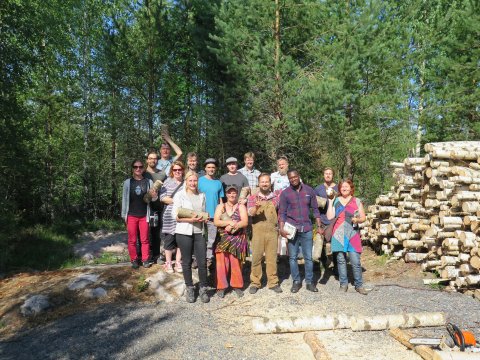On Thursday 28 June, the Finnish RAIN and Gifts from Metsä organised a mushroom workshop in Karjalohja in southern Finland. Seventeen stakeholders participated in the training session. Most of them were farmers, people who just started a mushroom business or had plans to start one, researchers and people who would like to grow mushrooms in their own garden or balcony. The course included both theory about mushroom cultivation and practical work where the participants could inoculate trees with mushroom mycelia themselves. The course was split in two sections: In the morning, the participants discussed more intensive farming of mushrooms, like how it is done at the forest farm of Gifts from Metsä. In the afternoon, the participants discussed more passive forest management techniques that involve using mushrooms as a tool to manage the forest.
 |
 |
|
|
Hands-on training: Inoculating birch logs with mycelia. |
A mushroom drill for drilling holes to fit the mushroom dowels. |
Shiitake, oyster and reishi mushrooms are cultivated in a more intensive way. Shiitake and oyster are consumption mushrooms and reishi is a medicinal mushroom frequently used in East Asia. Mushrooms are grown on birch logs piled in stacks. Aspen, alder and oak logs are also a suitable for growing these mushrooms. In the morning session, the participants were taught how to use a mushroom drill and mushroom dowels and how to make a mushroom totum which is suitable for large logs. When managed well, shiitake and oyster mushrooms can be harvested twice during the growing season, with about 8 weeks between harvests. A log can produce mushrooms for about 3-4 years.
 |
 |
|
|
Shiitake growing on birch stacks |
A mushroom totum |
The afternoon session was focussed on Shaga mushroom cultivation which is much less intensive and can be used as a forest management technique particularly suitable in combination with continuous cover forest management. Like reishi, also Shaga is a medicinal mushroom used in East Asia. Shaga mushroom cultivation can be combined with ecological forest management and can bring significant additional income for the forest owner from the sales of mushrooms. Inoculation with shaga mycelia is recommended on those birches which will be cut anyway during the first thinning. The value of birches harvested during first thinning is only a couple of euros, but the production of shaga mushrooms on a single birch can be worth 100 euros. After inoculation, the first shaga mushrooms are harvested after 5-6 years. Hereafter, it is still possible to get two additional mushroom harvests in the fifth year after the last harvest. Hereafter the tree can be harvested and sold as fire or fibre wood. This method of mushroom cultivation in combination with continuous cover forestry makes ecological forest management very profitable and it is possible to get a higher value from your forest as compared to clearcutting. During the training session, the participants got some hands-on experience on which trees would be best to select and hereafter they could inoculate the birches themselves.
 |
|
Shiitake growing on birch stacks in the Japanese way which is more suitable for steep slopes but unhandy in case you have to remove the log at the bottom |
At the end of the day, all participant received two bags of mushroom dowels with a mushroom species of their choice and a birch log as a growing substrate. Everyone was now very eager to start and try mushroom cultivation at home!
 |
|
After the course everyone was eager to start trying it at home! J |












